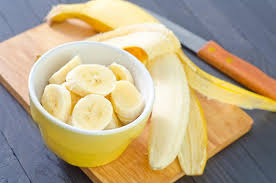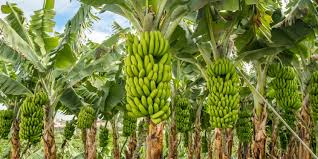Banana plants belong to the family Musaceae. They are primarily cultivated for their fruit, and to a lesser extent for the production of fibre and as ornamental plants. Due to their size and structure, banana plants are often mistaken for trees.
The main or upright growth is known as a pseudostem, which, in some species, can reach a height of 2–8 meters, with leaves extending up to 3.5 meters in length. Each pseudostem produces a single bunch of bananas before dying and being replaced by a new pseudostem.
Banana Fruit Structure and Nutritional Content
The banana fruit grows in hanging clusters, with up to 20 fruit on a tier (referred to as a “hand”), and 3-20 tiers forming a bunch. The total of the hanging clusters is known as a bunch or, commercially, as a “banana stem,” and it can weigh between 30–50 kilograms. The fruit typically averages 125 grams, of which approximately 75% is water and 25% is dry matter.
Each individual fruit, commonly referred to as a banana or ‘finger,’ has a protective outer layer (peel or skin) and a fleshy edible inner portion. Typically, the fruit contains numerous strings (known as ‘phloem bundles’) that run between the skin and the edible part, which are often removed after the skin is peeled. Bananas serve as a valuable source of Vitamin A, Vitamin B6, Vitamin C, and potassium.
Global Cultivation and Uses of Bananas
Bananas are grown in 132 countries worldwide, making them the most widely cultivated fruit crop. In popular culture and commerce, “banana” generally refers to the soft, sweet “dessert” bananas that are typically eaten raw.
Bananas from a group of cultivars with firmer, starchier fruit are usually used for cooking rather than eaten raw. Additionally, bananas can be dried and ground into banana flour. Although wild species produce fruit with numerous large, hard seeds, nearly all cultivated bananas have seedless fruits.
Bananas are classified either as dessert bananas (which are yellow and fully ripe when eaten) or as green cooking bananas. Most export bananas belong to the dessert variety; however, only 10-15% of all banana production is intended for export, with the United States of America (USA) and the European Union (EU) being the dominant buyers.
Domestication and Origins of Bananas
The domestication of bananas took place in southeastern Asia. Several species of wild bananas still exist in New Guinea, Malaysia, Indonesia, and the Philippines. Archaeological and palaeoenvironmental evidence from Kuk Swamp in the Western Highlands Province of Papua New Guinea suggests that banana cultivation in this region dates back to at least 5000 BC, possibly as early as 8000 BC.
This indicates that the New Guinean highlands may have been the first region where bananas were domesticated. It is likely that other wild banana species were later domesticated in other parts of southeastern Asia.
Read Also: For how long can I store feeds before giving them to the fish?
Origins of Edible Bananas

All edible bananas originate, either wholly or partially, from Musa acuminata, which is native to the Malay Peninsula and nearby regions. In prehistoric times, plants with seedless fruits were selectively propagated vegetatively from suckers. Although most bananas are grown by small farmers in tropical countries for local consumption, large commercial operations also exist, exporting bananas from tropical regions to wealthier countries in temperate zones.
Varieties of Bananas and Their Uses
Bananas come in a wide range of sizes and colors, with most cultivars being yellow when ripe, though some are red. The ripe fruit is easy to peel and can be eaten raw or cooked. Depending on the cultivar and ripeness, the flesh may range from starchy to sweet and from firm to soft. Unripe or “green” bananas and plantains are typically used in cooking and serve as a staple starch for many tropical populations.
Local and Commercial Production
Most banana production for local markets involves green cooking bananas and plantains, as ripe dessert bananas are more easily damaged during transport. Even when transported only within their country of origin, ripe bananas suffer high rates of damage and loss. The commercial dessert varieties, predominantly Musa acuminata or the hybrid Musa x paradisiaca (a cultigen), are imported in large quantities to temperate countries from tropical regions.
These varieties are especially popular due to their availability year-round, as bananas are a non-seasonal crop. Among these varieties, the ‘Cavendish’ cultivar is the most significant, accounting for the vast majority of bananas exported from tropical regions.
Hybridization and Development of Banana Varieties
Musa acuminata, native to the Malay Peninsula and nearby areas, is considered the progenitor, either in full or part, of all edible banana varieties. Some banana varieties have resulted from hybridization between Musa acuminata and Musa balbisiana, the latter of which is found from India to the tropical Pacific.
This hybridization likely occurred as Musa acuminata plants (2n genome = AA) were increasingly cultivated within the distribution range of Musa balbisiana (2n genome = BB). Although Musa acuminata cultivars were sterile due to their seedless nature, they did produce fertile pollen.
Read Also: Maggot Feeding: Can You Feed Fishes with Maggots?
Pests and Diseases

Although bananas are not at risk of extinction, popular edible cultivars like ‘Cavendish’ face threats due to diseases. The predecessor of ‘Cavendish,’ the ‘Gros Michel,’ was largely replaced due to its vulnerability to disease. Diseases affecting banana cultivation include:
1. Panama Disease (Race 1): Fusarium wilt, a soil fungus, infects plants through the roots and moves upward, cutting off water and nutrient flow. This disease led to the replacement of ‘Gros Michel’ with ‘Cavendish.’ Although ‘Cavendish’ is resistant to Race 1, it is still susceptible to other diseases.
2. Tropical Race 4 (TR4): A virulent strain of Panama Disease discovered in 1993. It has devastated banana plantations in Southeast Asia and is likely to reach the Americas. TR4 poses a significant threat to ‘Cavendish’ bananas.
3. Black Sigatoka: A fungal leaf spot disease first observed in Fiji in the 1960s. It reduces banana yields by turning leaves black and impeding photosynthesis. Black Sigatoka has shown increasing resistance to fungicides, making it challenging and expensive to control.
4. Banana Bunchy Top Virus (BBTV): Spread by aphids, BBTV stunts leaves, causing a “bunched” appearance. Infected plants usually do not produce fruit. The virus can be minimized by planting tissue-cultured plants and removing infected plants immediately.
These diseases pose significant challenges to banana cultivation, affecting both commercial and small-scale farming. Although disease-resistant varieties have been developed, issues with taste and texture have slowed their commercial acceptance. Hybridization and genetic engineering programs are working to create disease-resistant bananas for mass-market consumption.
Trade and Uses of Bananas

Bananas are one of the most widely consumed foods globally, especially in tropical regions where they serve as a major food source and income for smallholder farmers. In East Africa, bananas are a staple food, with countries like Uganda, Burundi, and Rwanda having the highest per capita consumption.
However, banana farmers often receive low prices for their produce due to supermarkets negotiating lower prices. Major banana companies such as Chiquita, Del Monte, Dole, and Fyffes dominate production in countries like Ecuador, Colombia, Costa Rica, and Guatemala.
The banana export market is dominated by a few cultivars, particularly ‘Cavendish,’ which is chosen for its transport and shelf-life properties rather than taste. Bananas are picked green and ripened using ethylene gas in controlled rooms upon arrival at their destination. The temperature at which bananas ripen affects their flavor and texture. Export bananas are typically shipped at temperatures between 12 and 14°C to prevent spoilage.
In addition to fresh fruit, bananas are used to make banana chips, jams, and are even incorporated into Southeast Asian and Indian cuisines using the banana flower or banana heart. Bananas are also a valuable export product for many tropical countries and play a significant role in international trade.
Do you have any questions, suggestions, or contributions? If so, please feel free to use the comment box below to share your thoughts. We also encourage you to kindly share this information with others who might benefit from it. Since we can’t reach everyone at once, we truly appreciate your help in spreading the word. Thank you so much for your support and for sharing!
Read Also: The Impact of Inefficient Waste Management on Oceans
Frequently Asked Questions
We will update this section soon.

